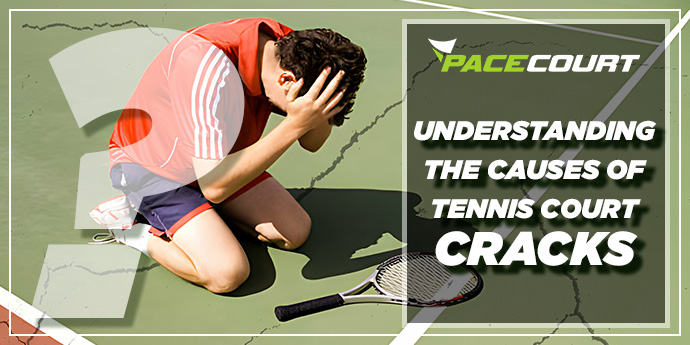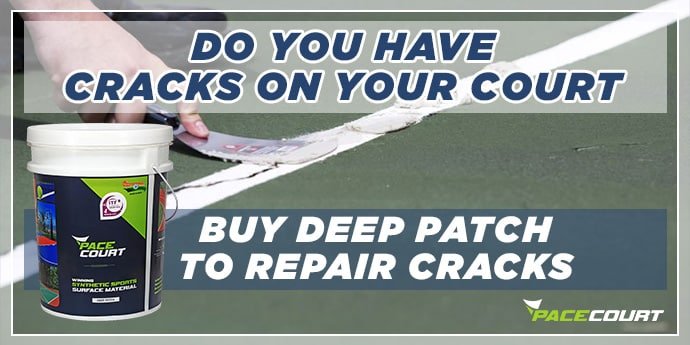Introduction
Tennis courts are for playing; without them, no sports facility could ever be complete. Their surfaces give athletes surroundings that improve performance while being safe and long-lasting. However, cracks are one of the most common problems that can arise on even the most meticulously designed courts. A tennis court with cracks in it has an impact not only on how it looks but also on how much players enjoy their games, how safe they are to use, and how long the court will survive. Anyone involved in installation, maintenance, or even just enjoying these lovely games should be aware of the factors that can lead to this kind of damage, especially to acrylic surfaces.
This article aims to give a general overview of the causes of tennis court cracks, specifically focusing on outdoor courts with acyclic surfaces. Other areas of concern include material quality, installation techniques, maintenance schedules, and environmental variables that are being investigated. There will also be real-world examples that illustrate how important it is to identify and manage these circumstances to prevent needless costs and prolong the life of a tennis court.
The Nature of Acrylic Tennis Courts
Acrylic is highly favored for outdoor tennis courts due to its strength, aesthetic appeal, and ability to provide a level playing field. These layers are the base coat, the texture coat (which includes any fine or rough texturing on top), and the finish layer, each of which has a distinct purpose. When these layers are applied properly, the result is a surface that is resilient to both heavy foot traffic and adverse weather conditions. It also enhances player performance by giving players superior footholds during play and ideal ball rebounds.
Common Causes of Tennis Court Cracks
Subgrade Instability
The subgrade of any tennis court can act as its base, providing the necessary upper-level stability. In the long run, issues may arise from an unstable subgrade. Various factors, including inadequate soil composition, incorrect compaction, and water infiltration, can cause the subgrade to shift or settle unevenly. These settings or changes beneath it may cause the acrylic surface above to break.
Thermal Expansion and Contraction
Acrylic surfaces expand and contract in response to changes in temperature. Heat during the day causes this material to increase, whilst chill at night causes it to become smaller. A continual motion like this may lead to strain between the upper layers, which would cause cracks unless the park's design prevented such motions.
Moisture Penetration
Water damages acrylic tennis courts significantly. Moisture can penetrate the surface through microscopic openings such as exposed surface layers and unsealed fissures. Once water penetrates the substrate, it can break down the connections that keep the layers together, causing separation and stone breaking. In colder climates, this water could freeze and expand, worsening the situation.
Poor Installation Practices
Even with high-quality materials, improper installation might lead to failure. Weak spots that are prone to cracking can be the consequence of improper installation practices, such as applying layers unevenly, mixing acrylic components incorrectly, or hurrying the curing process. Ensuring the longevity of your court requires hiring seasoned personnel who conduct tasks correctly.
Aging and Wear
Acrylic surfaces have a lifespan, just like any other material. The surface layers may get harder with time, increasing their propensity to fracture with tremendous force. It is thought that for acrylic courts to remain durable for an extended period, frequent maintenance procedures including cleaning, resurfacing, and recoating must be carried out on them; eventually, this will need to be altered.
Preventing and Repairing Tennis Court Cracks
Proper Site Preparation
The location must be carefully prepared before applying any acrylic layers. This means leveling the terrain, permitting drainage, and stabilizing the subgrade. A spot that has been prepared will be less likely to move or settle, which reduces the likelihood that further fissures may form.
Use of High-Quality Materials
Tennis courts last a lot longer since premium acrylic materials are used, and they should be applied in the proper proportion. High-quality materials are resistant to bad weather, which keeps us dry for a long time.
Regular Maintenance
An acrylic tennis court needs regular maintenance to be in excellent shape. This entails clearing trash from the surface, looking for wear indicators, and fixing small cracks or damage before it gets worse. Maintaining the integrity of the surface can also be aided by periodically recoating it with new acrylic.
Professional Installation
Hiring a skilled tennis court constructor is one of the greatest ways to make sure your court lasts as long as possible because a tennis court's age and condition have a significant impact on how long it will last. Experts have the knowledge and skills to address issues before they worsen, thereby saving time and costs.
Monitoring and Addressing Environmental Factors
The climate and environment of a particular area should be taken into consideration when designing an effective tennis court. For instance, expansion joints can be used to avoid thermal cracking in places that have big temperature variations. In most areas, better drainage and water-resistant materials would help protect the court.

Case Studies
Case Study: Installation Errors in a Community Court
A tennis court in Chennai developed wear cracks within the first year of operation. An investigation revealed that the acrylic layers were applied unevenly and that expedited curing was used because of an impending event. These expedients are harmful to surface integrity and lead to premature cracking. The court was reinstalled by a qualified contractor, and the crack has not appeared for several years.
Case Study: Moisture Issues in a Delhi Tennis Court
A particularly wet winter in Delhi resulted in significant cracks in a tennis court. Water that had crept into the cracks during the rainy season was the cause of them. The liquid expanded inside the layers as the temperature dropped and froze, wreaking havoc. By applying an acrylic topcoat that would withstand water better and improve the court's drainage system. The institution was able to avert similar occurrences in the future.
Case Study: A Subgrade Failure in Gujrat
A few months after it was finished, cracks began to appear in the Gujrat tennis court complex. Non-uniform settling was caused by poorly compacted subgrade, according to research. In locations where the composition of the soil varied, these fissures were noticeably more noticeable. The subgrade was stabilized, and the court's structural integrity was restored with the application of fresh acrylic layers.
Consult with Our Experts
Are you worried about cracks in your tennis court? Contact Pacecourt today for a free consultation with our experts. We'll help you diagnose the problem and offer tailored solutions to keep your court in shape.

Conclusion
While some cracks in a tennis court are just aesthetic, in others they could pose a serious safety risk, making play on the surface challenging or even impossible. It's critical to comprehend the reasons behind these breakdowns and how to avoid them in outdoor courts with acrylic surfaces to stop additional harm from happening. This includes everything from properly preparing the site and selecting high-quality materials to routinely maintaining your court and hiring a skilled installer—all of these things will eventually decide how successful your tennis court is in the long run.
It is evident from the case studies that cracks, even when they appear, typically have distinguishable and preventable causes. Facilities can take a lesson from these incidents to avoid such problems in the future and maintain their courts for an extended period.
Frequently asked question
Acrylic flooring is part of a synthetic surface made from layers of acrylic resin applied over a prepared base, typically concrete or asphalt. It provides a durable, consistent, and low-maintenance playing surface ideal for tennis courts.
The main difference is the number of layers of acrylic resin and coatings applied. A 5-layer system includes base, resin, color, and topcoat layers, while an 8-layer system adds more resin and color layers for increased durability, enhanced aesthetics, and better performance.
The installation time for an acrylic tennis court surface can vary based on the specific project requirements and weather conditions. Generally, it takes about 1 to 2 weeks to complete, including preparation, layering, and curing times.
Acrylic flooring offers several advantages, including consistent ball bounce, low maintenance requirements, durability, quick drying times, and enhanced player safety. It is also customizable in terms of color and texture.






